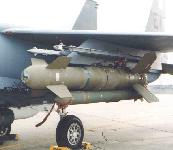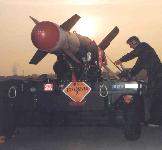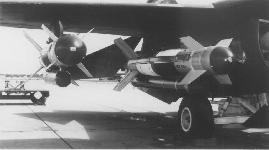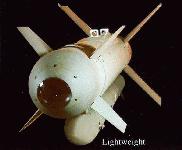



The Air-to-Ground Guided Missile-130 (AGM-130) is a powered air-to-surface missile designed for high- and low-altitude strikes at standoff ranges against a variety of targets. The AGM-130 is integrated on the F-15E which is capable of carrying two missiles, one on each inboard store station. The AGM-130 Surface Attack Guided Munition program provides the Air Force with a retargetable, precision guided standoff weapon using inertial navigation aided by Global Positioning System (GPS) satellites. The AGM-130 is designed to attack high value fixed, relocatable or slow moving targets from 15 - 40 NM range. The AGM-130A is a powered version of the Guided Bomb Unit-15 munition, and provides a significantly increased standoff range beyond that of the GBU-15. The munition allows the aircraft to remain at a distance from the target and uses man-in-the-loop guidance with either a television or infrared seeker and a 2,000-pound general purpose warhead.
Carrying forward the modular concept of the GBU-15 guided weapon system, the AGM-130A employs a rocket motor for extended range and an altimeter for altitude control. The modular AGM-130 missile consists of a charge coupled device TV or focal plane array imaging infrared seeker, adapter (with built-in radar altimeter), wings, strakes, Mk84 or BLU-109 warhead, control section, rocket motor and data link.
The AGM-130A is equipped with either a television or an imaging infrared seeker and data link. The seeker provides the launch aircraft a visual presentation of the target as seen from the weapon. During free flight this presentation is transmitted by the AXQ-14 data-link system to the aircraft cockpit monitor. The seeker can be either locked onto the target before or after launch for automatic weapon guidance, or it can be manually steered by the weapon systems officer. Manual steering is performed through the two-way data link.

For the primary mode of operation, the aircraft flies to a pre-briefed launch position. Survivability of aircraft and crew is enhanced by launching the weapon at low altitude and significant standoff range, thus avoiding detection by enemy air defenses. Precise attack is provided through the transmission of seeker signals to the aircraft data link pod attached to the controlling aircraft centerline stores station. The Weapon System Operator (WSO) operates the missile through standard cockpit controls. After launch the AGM-130 navigates to preprogrammed target area coordinates using a GPS aided inertial navigation system. The weapon flies through glide-powered-glide phases toward the target area with midcourse guidance updates provided by global positioning system (GPS) navigational information or through the data link. Upon termination of the powered flight phase the rocket motor is ejected.
As the target comes into view, the weapon systems officer has dual flexibility in guiding the weapon via the data link. For automatic terminal homing, the guidance tracker is locked on target but can be manually updated for precision bombing. When total manual guidance is used, the operator manually guides the weapon to the target aimpoint. Fifteen seconds prior to impact, the WSO locks-on to the target using the seeker tracker or manually tracks to the precise target impact point. For those aircraft not equipped with a data-link pod, the weapon may be launched in the direct attack mode (lock-on before release), as well as the primary indirect attack mode. An additional capability is inflight missile retargeting. Real time targeting information is uploaded to the F-15E while inflight through the AXQ-14 Data link pod. The WSO then reprograms weapon target coordinates and attacks the new target.The AGM-130A is designed to be used with F-15E aircraft. The AGM-130 system is capable of rapid worldwide deployment operating from main operating bases, collocated operating bases, and bare base (remote) sites. The system uses mobile support equipment to provide an organizational and intermediate level maintenance support capability. Development of the AGM-130A began in 1984 as a product improvement of the GBU-15 guided glide bomb. The first unit was operational in 1994. The acquisition category (ACAT) is ACAT II with an Air Force precedence rating of 2-06.
The AGM-130 Mid-Course Guidance [MCG] weapon, employs improved global positioning and inertial navigation systems. These upgrades allow the weapon to pursue targets with less involvement from the weapons systems officer in the aircraft. These new missiles have the ability to guide to the target with global positioning system steerage, freeing the hands and minds of the aircrew to concentrate on the tasks at hand in a high enemy threat environment. Two F-15Es from the 335th and 336th Fighter Squadrons at Seymour Johnson AFB NC, fired two upgraded AGM-130s during the weapon�s first launches by operational aircrews at Eglin AFB in early December 1998.
The AGM-130LW [lightweight] is designed with global positioning system and inertial navigation system capability permitting a single-seat fighter to launch and control the weapon. The lightweight version of the AGM-130, tested from an F-16 aircraft in 1998, provides an all-weather, long-range precision standoff weapon for F-16C/D and F-15E aircraft increasing their standoff capability by 10-20 percent. It also provides better control over collateral damage because it does not carry as much explosive as the original AGM-130."
A further improvement, AGM-130C, developed, but not produced by the Air Force, adapts the munition to a 2,000-pound penetrating warhead. The Autonomous AGM-130 is a proposed P3I to the production weapon to incorporate an autonomous LADAR seeker. The current weapon is employs a strap-on rocket motor and utilizes an INS/GPS midcourse guidance capability. The seeker hardware would be NDI developed for a prior weapon application. Nonrecurring costs would be incurred to develop target detection algorithms for the target set specific to the AGM-130 mission. The aircraft interface would be modified to a JDAM interface. Use of the autonomous seeker will significantly reduce the mission planning timelines and reduce the aircrew workload. In addition, elimination of the datalink pod will reduce the susceptibility to countermeasures and shrink the logistic footprint.Specifications | |||||||||||||
| Primary Function: | Air-to-surface guided and powered bomb | ||||||||||||
| Mission | Offensive counter air, close air support/interdiction, suppression of enemy air defenses, naval anti-surface warfare | ||||||||||||
| Targets | Fixed hard, fixed soft | ||||||||||||
| Service | Air Force | ||||||||||||
| Contractor: | Rockwell International Corp. | ||||||||||||
| Thrust: | Classified | ||||||||||||
| Length: | 12 feet, 10.5 inches (3.90 meters) | ||||||||||||
| Launch Weight: | 2,917 pounds (1,312.65 kilograms) | ||||||||||||
| Diameter (in.) | 15/18 (bomb); 9 (rocket motor) | ||||||||||||
| Wingspan: | 59 inches (149.86 centimeters) | ||||||||||||
| Range: | more than 40 miles | ||||||||||||
| Accuracy: | |||||||||||||
| Ceiling: | 30,000-plus feet (9,091 meters) | ||||||||||||
| Speed: | Classified | ||||||||||||
| Guidance System: | television or imaging infrared seeker | ||||||||||||
| Warhead | BLU-109/MK 84 | ||||||||||||
| Explosive | Tritonal 945 lbs. (MK-84); 535 lbs. (BLU-109) | ||||||||||||
| Fuze | FMU-124A/B (Nose and Tail, MK-84); FMU-143 (Tail, BLU-109) | ||||||||||||
| Program status | Production | ||||||||||||
| Date Deployed: | December 1994 (F-111 F) | ||||||||||||
| Inventory: | The missile is in production. When in the inventory the number will be classified. The Air Force had planned to buy about 4,048 kits. However, that number was reduced to about 2,300 units and for fiscal year 1995 was further reduced to 502. Currently eight lots of AGM-130 missiles have been authorized for a total procurement quantity of 674. | ||||||||||||
| Development cost | $192.048 million [The cost is for the AGM-130 only. Air Force reports development cost for the AGM-130C at $11.513 million.] | ||||||||||||
| Production cost | $443.908 million | ||||||||||||
| Total acquisition cost | $647.47 million | ||||||||||||
| Acquisition unit cost | $1.27 million | ||||||||||||
| Production unit cost | $884,279 The Air Force never awarded a full-rate production contract and the production unit cost of the munition rose from an estimated $261,500 to $884,279. | ||||||||||||
| Relative costs of AGM-130 components |
| ||||||||||||
| Platforms | F-15E, F-111 | ||||||||||||





